
The Star Wars space opera universe, created by George Lucas, features some dialogue spoken in fictional languages. The lingua franca of the franchise is known in-universe as Galactic Basic, which refers to the language of the film or work itself, be it English or a language that the work was dubbed or translated into.
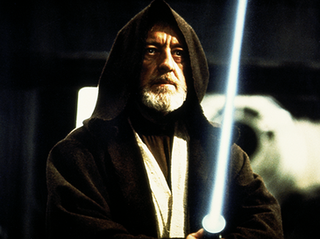
Obi-Wan Kenobi is a character in the Star Wars franchise. In the original film trilogy, he is a Jedi Master who trains Luke Skywalker in the ways of the Force. In the prequel trilogy, he mentors Luke's father, Anakin Skywalker. Obi-Wan is portrayed by Alec Guinness in the original trilogy and by Ewan McGregor in the prequel films. McGregor also plays the character in the television series Obi-Wan Kenobi. Guinness' performance in Star Wars (1977) earned him the Saturn Award for Best Supporting Actor, as well as a nomination for the Academy Award for Best Supporting Actor.

Qui-Gon Jinn is a fictional character in the Star Wars franchise. He was introduced as a Jedi Master in the prequel film The Phantom Menace (1999), and is portrayed by Liam Neeson. He appears in the series Tales of the Jedi, and is featured as a Force spirit in the animated series The Clone Wars (2008) and the live-action miniseries Obi-Wan Kenobi (2022). Qui-Gon also appears in novels, comics and video games.
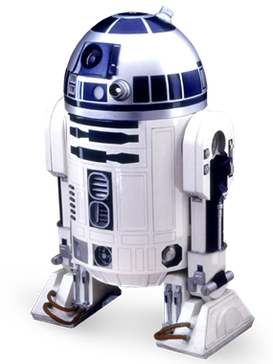
R2-D2 or Artoo-Detoo is a fictional robot character in the Star Wars franchise created by George Lucas. He has appeared in ten of the eleven theatrical Star Wars films to date, including every film in the "Skywalker Saga", which includes the original trilogy, the prequel trilogy and the sequel trilogy. At various points throughout the course of the films, R2, an astromech droid, is a friend to C-3PO, Padmé Amidala, Anakin Skywalker, Leia Organa, Luke Skywalker, and Obi-Wan Kenobi. R2-D2 and his companion C-3PO are the only characters to appear in every theatrical Star Wars film, with the exception of Solo: A Star Wars Story (2018).

C-3PO or See-Threepio is a humanoid robot character in the Star Wars franchise. He is a protocol droid designed to assist in etiquette and translation, and is fluent in over six million forms of communication. The character appears in all nine films of the Skywalker Saga—which includes the original trilogy, the prequel trilogy and the sequel trilogy. Anthony Daniels portrays C-3PO in all the Skywalker Saga films and the standalone film Rogue One, and voices the droid in the animated film The Clone Wars. In addition to films, C-3PO appears in television series, novels, comics, and video games.
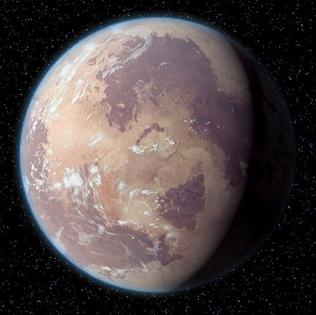
Tatooine is a fictional desert planet that appears in the Star Wars franchise. It is a beige-colored, desolate world orbiting a pair of binary stars, and inhabited by human settlers and a variety of other life forms. The planet was first seen in the original 1977 film Star Wars, and has to date featured in a total of seven Star Wars theatrical films, three live-action television series, and four animated series.

Watto is a fictional character in the Star Wars franchise, featured in the films The Phantom Menace and Attack of the Clones. He is computer-generated and is voiced by voice actor Andy Secombe. He is a mean-tempered, greedy Toydarian, and owner of a second-hand goods store in Mos Espa on the planet Tatooine. Among Watto's belongings are the slaves Shmi Skywalker and her son, Anakin. He acquires them after winning a podracing bet with Gardulla the Hutt, and he puts them both to work in his store. Anakin demonstrates an incredible aptitude for equipment repair, and Watto decides to profit from it by having the boy fix various broken equipment in the store. He eventually loses Anakin in a podracing bet with Qui-Gon Jinn when he bets on a competitor, Sebulba, who is defeated by Anakin.

The Skywalker family is a fictional legendary human family in the Star Wars franchise. Within the series' fictional universe, the Skywalkers are presented as a bloodline with strong inherent capabilities related to the Force and sometimes lightsaber skills. Luke Skywalker, his twin sister Princess Leia Organa, and their father Darth Vader are central characters in the original Star Wars film trilogy. Darth Vader, in his previous identity as Anakin Skywalker, is a lead character in the prequel film trilogy and so is his wife and the twins' mother Padmé Amidala; while his mother Shmi is a minor character in the first and second films respectively. Leia and Han Solo's son, Ben Solo, renamed himself Kylo Ren and is the main antagonist in the sequel film trilogy, while they and Luke serve as supporting characters. Shmi, Padmé, and Han are the only members who are not Force-sensitive. The Skywalker bloodline, alongside the Palpatine bloodline, are the two bloodlines that are the strongest with the Force.
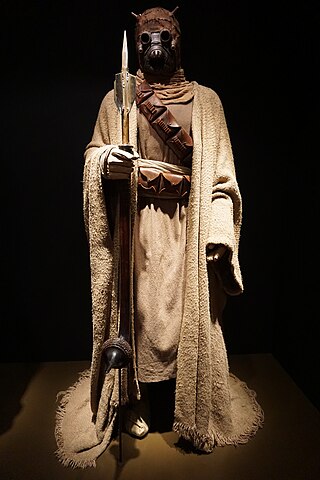
Tusken Raiders are a fictional alien race in the Star Wars franchise. They first appeared in Star Wars (1977).

Banthas are fictional creatures in the Star Wars franchise. They are large, quadrupedal mammals with long, thick fur, and are first seen in the film Star Wars (1977), where they are used as beasts of burden by Tusken Raiders on the planet Tatooine. They have since been featured in several other Star Wars works, including the Special Edition version of Return of the Jedi (1983), the prequel films The Phantom Menace (1999) and Attack of the Clones (2002), and the television shows Star Wars: The Clone Wars, The Mandalorian, and The Book of Boba Fett, as well as video games and books.

The Tantive IV Alderaan Diplomatic Envoy is a fictional spaceship in the Star Wars film series. Designed by the Corellian Engineering Corporation (CEC), the highly modified CR90 corvette is designed to be utilitarian, durable, modular, similar to its predecessors like the CR70 with its simplistic interiors featuring subtle luxury for Alderaan officials. It was used by Leia Organa in the original Star Wars film and was the first vessel audiences saw when Star Wars premiered in 1977. Other CR90 Corellian corvettes, which share the Tantive IV's design, appear in Return of the Jedi and in the Star Wars Expanded Universe's books, comics, TV series, and games.

The Max Rebo Band is a fictional alien pop music band in the Star Wars franchise, first appearing in the 1983 film Return of the Jedi as in-house performers for crime lord Jabba the Hutt. The lineup originally seen in the film consists of the blue-skinned Ortolan organist Max Rebo, a plump Kitonak woodwind player named Droopy McCool, and the Pa'lowick lead singer Sy Snootles, while additional members were inserted into the later-edited Special Edition of the film. A great deal of further information about the band and the personal histories of its members is found in various literature of the now-noncanonical Star Wars Expanded Universe.

The Star Wars Episode I: The Phantom Menace novelization was written by Terry Brooks and published on April 21, 1999, by Del Rey. It is based on the script of the film of the same name and released with multiple covers, including Darth Maul, Obi-Wan Kenobi, Anakin Skywalker and Queen Amidala.
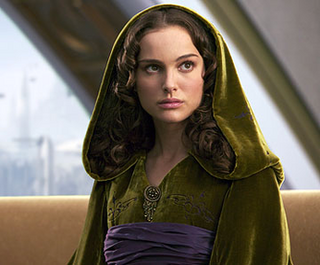
Padmé Amidala is a fictional character in the Star Wars franchise. She first appeared in the 1999 film The Phantom Menace as the teenage queen of the fictional planet Naboo. In the following two films of the prequel trilogy, Padmé becomes a member of the Galactic Senate and secretly marries Anakin Skywalker, a Jedi Knight. Anakin's fear of losing Padmé drives him toward the dark side of the Force, which results in his transformation into Darth Vader. Padmé eventually dies after giving birth to the twins Luke Skywalker and Leia Organa. Natalie Portman portrays Padmé in all three prequel films. In addition to films, Padmé appears in animated series, novels, comics and video games.
Lego Star Wars: The Quest for R2-D2 is a 2009 comedy short film directed by director Peder Pedersen and produced by M2Film for Lego and Cartoon Network in collaboration with Lucasfilm.
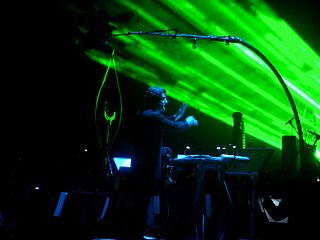
Star Wars: In Concert, previously referred to as Star Wars: A Musical Journey, is a series of concerts featuring a symphony orchestra and choir, along with footage from the Star Wars saga films displayed on a large LED screen at three stories tall. The screen is set to live performances of the Star Wars score composed by John Williams. The first performance took place in The O2 Arena in London, England and was attended by approximately 20,000 fans. The first North American tour started in Anaheim, California on October 1, 2009, and the second and most recent North American tour ended in London, Ontario on April 14, 2015. The concert series was scheduled to return sometime in 2016, but has since been delayed.















